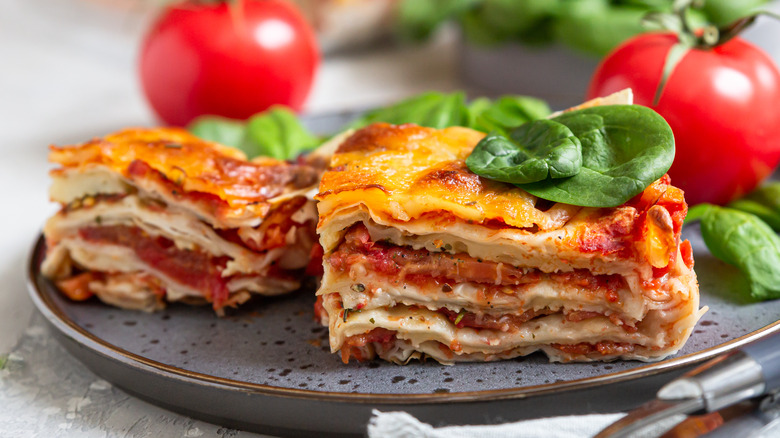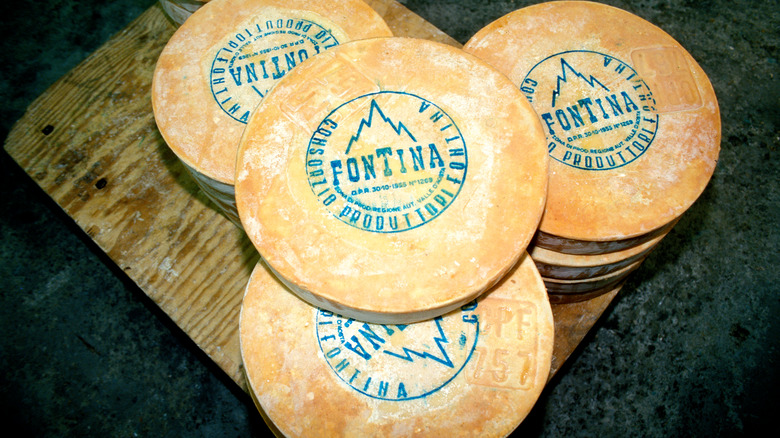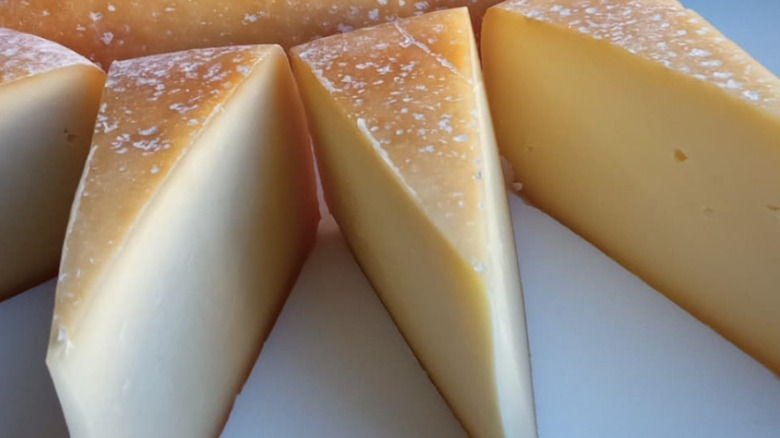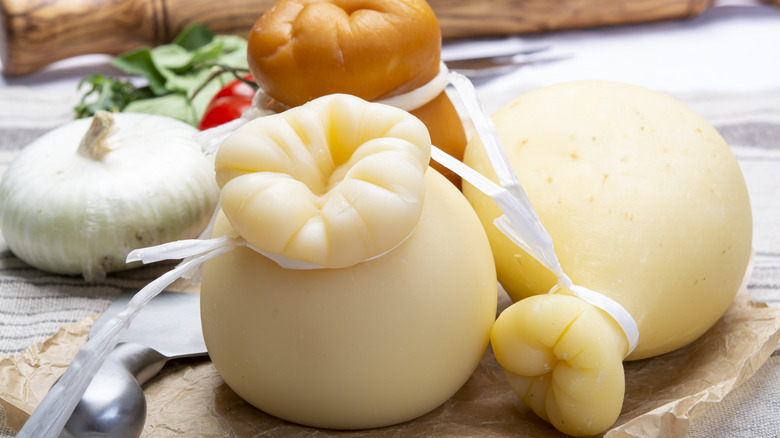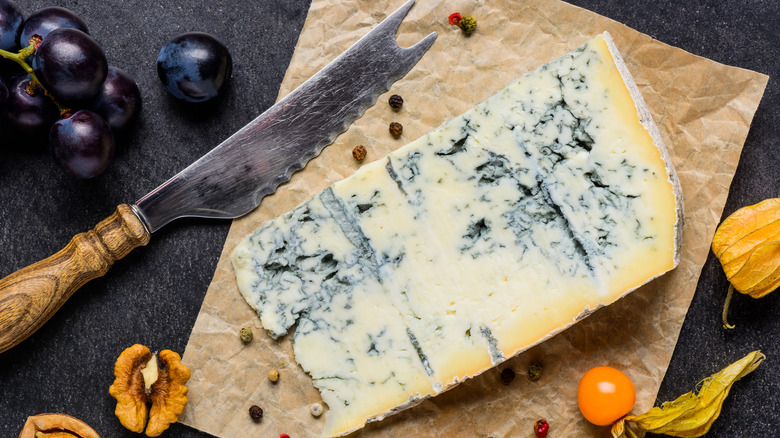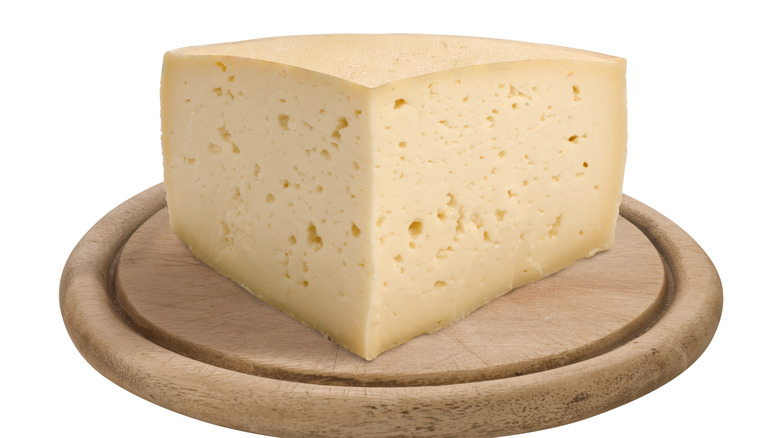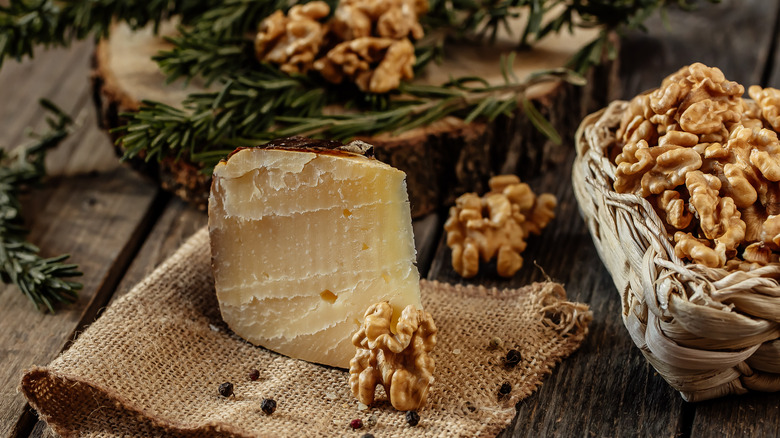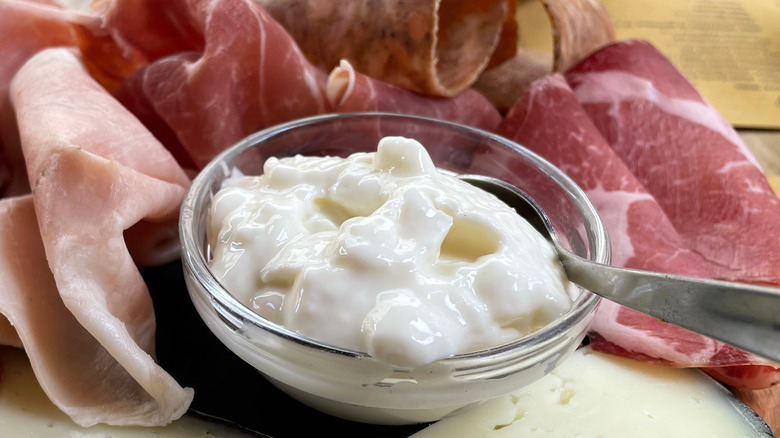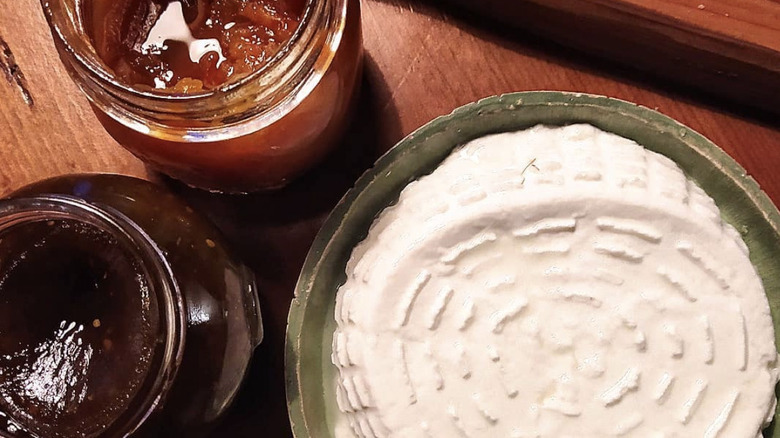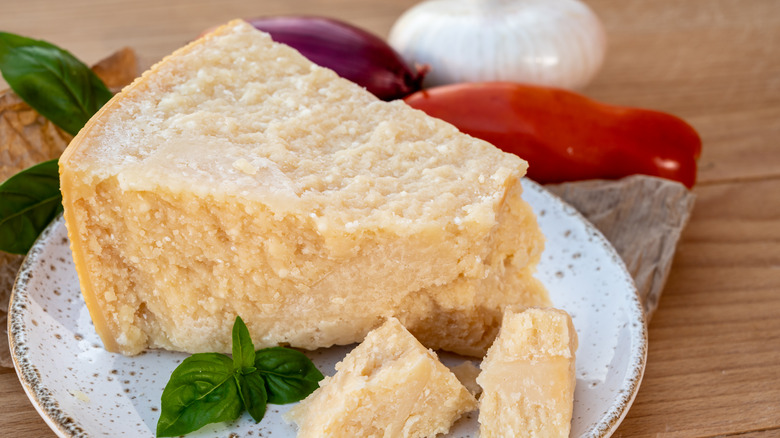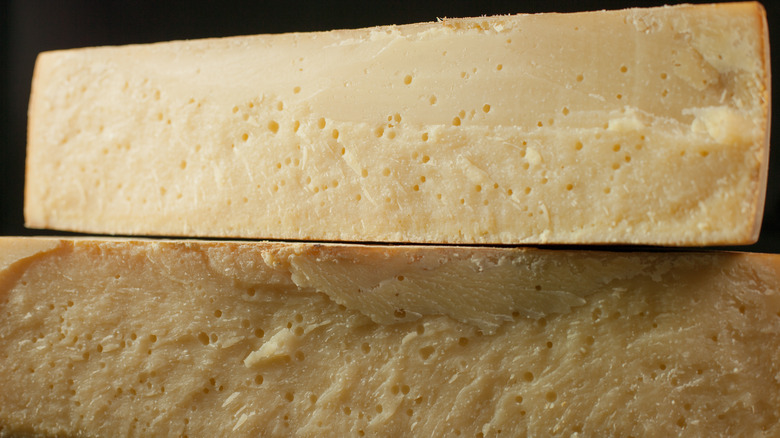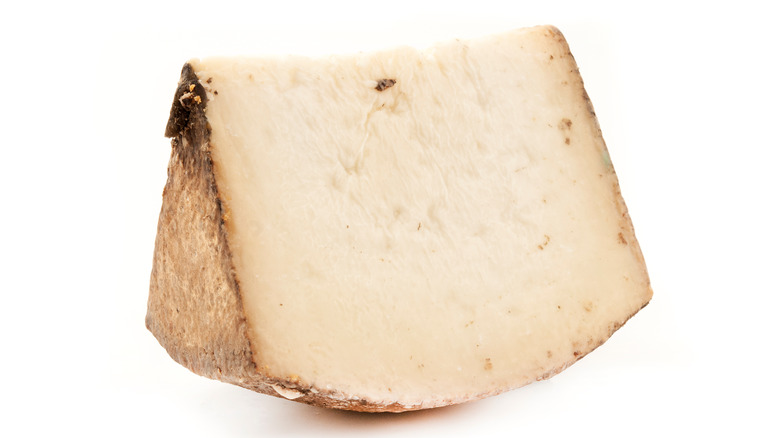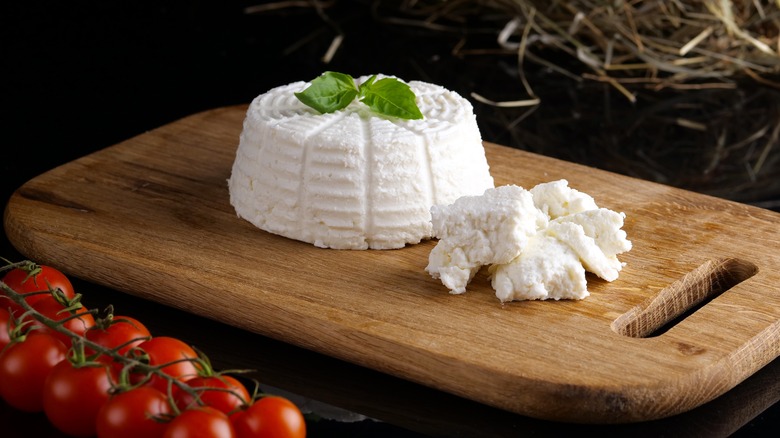11 Underrated Cheeses That Can Seriously Upgrade Your Lasagna
When you order lasagna at an Italian restaurant, it's likely that your meal contains some combination of ricotta, mozzarella, and parmesan cheeses. This trilogy of cheeses is accessible in many American supermarkets and is easy to add to pre-made lasagna sheets. Home cooks certainly know the drill: Cover your squares of pasta with red sauce and ricotta, layer them, top your creation with an additional layer of gooey mozzarella, and finish it with a top coating of parm. Then, presto! You have a basic batch of lasagna.
Although this lasagna-making method is generally a crowd-pleaser, it doesn't always make for the meal's fanciest version. Throughout Italy, there are many different lasagna variations with differing cheese combinations. If you want to make lasagna "the Italian way," experiment with cheese varieties. Adding a sharper, creamier, or thicker cheese to your recipe will change the taste and texture of your creation. From aged cow cheeses like Fontina d'Aosta to tangy cheeses like Squacquerone, here are a few options that can seriously elevate your lasagna dishes at home.
Fontina d'Aosta
If you're searching for a high-quality cheese to upgrade your lasagna, look no further than fontina d'Aosta. The production methods for this type of cheese begin with how the farmers treat their red-pied Valdostana cows. Unlike many husbandry practices, these cows don't spend their days cramped in tiny farm stalls. At the base of the Italian alps, these cows wander wide pastures. After milking them, their milk undergoes little processing. Instead of pasteurizing the cheese, cheesemakers store the fontina d'Aosta in caves beneath nearby mountains — aging them in a low-temperature environment to give the cheese its unique texture.
As a result, the cheese has a sharp yet buttery flavor — tasting sublime in dishes like fontina grilled cheese. Some varieties even take on a hint of nuttiness. However, fontina has a more intense flavor than mozzarella — mostly due to the aging process. To upgrade your lasagna, you can easily substitute the soft creaminess of mozzarella for the more complex fontina. Simply shred a few cups of fontina and sprinkle it generously over the top of your creation before popping it into the oven. If, however, you're worried that an all-fontina pasta plate will be too strong, you can always top your creation with a mozzarella/fontina blend. This will add flavor to your lasagna without overwhelming your dinner guests with fontina's intensity.
Bel Paese
Fontina d'Aosta isn't the only flavorful cheese you can use as a mozzarella substitute in lasagna. Bel paese will also elevate your creation's upper layer. Meaning "beautiful country" in Italian, bel paese was invented in 1906 as cheesemaker Egidio Galbani's response to the French Alps' renowned cheeses. Galbani's invention is known for its milky, almost sweet flavor. However, the product typically ages around six to eight weeks, so it's generally stronger than mozzarella. Additionally, bel paese's consistency is harder as the cheese's interior contains little holes called "eyes."
If you are searching for a cheese that shreds easily and melts like mozzarella but offers a slightly deeper flavor, then bel paese is probably your best bet. Just like its alternative, bel paese will melt into that beautiful gooey layer that tops your lasagna. However, it will also add, in the words of igourmet, "more body and tang" to your final creation. In that sense, bel paese is an ingredient that can give a bit of "oomph" to your lasagna without seriously changing your overall cooking routine.
Provolone
Provolone cheese may seem like it's best suited for a sandwich, but that's far from being the whole story. While you can technically find provolone produced in the United States or Japan, the real deal — the one that holds the European Union's coveted Protected Designation of Origin label — comes from Italy. Unlike American provolone, which is aged for only two months, the Italian version ages anywhere from four months to one year. As a result, Italian provolone takes on a sharper, fuller flavor that simply cannot be compared to your standard meatball sub melt.
Due to the vast differences between American and Italian provolone production methods, it is recommended that you use the original, European provolone to upgrade your lasagna. This semisoft cow's milk cheese doesn't only melt beautifully, but it also can add a nutty yet buttery taste to your creation.
To add provolone to your lasagna, you could start out using the lighter and sweeter provolone: doce. This delicious type of provolone is perfect to layer between lasagna sheets. Not only is it stretchy and gooey, but it also will bring a deeper flavor to your meal's inner levels. Later, reach for the stronger, more aged provolone piccante: Sprinkle a tad over the upper layer of mozzarella. This cheese is stronger and even a bit spicy, meaning that it will give your lasagna a complex finish.
Spicy gorgonzola
Provolone isn't the only type of Italian cheese with a piccante version: Gorgonzola has one as well. Known in English as spicy gorgonzola, this delicious blue cheese is known for its powerful, pungent taste. The cheese's intense sharpness gives it the reputation for being on the spicier side. This unique flavor is achieved through an intense aging process that lasts for a minimum of eighty days. However, some brands of gorgonzola piccante age for a whole year. In the end, the final result is worth the wait. Gorgonzola piccante has a uniquely rich and creamy flavor.
While this delicious type of blue cheese is famous for tasting great in salads, such as this delightful celery and endive combo, it also pairs wonderfully with the earthy notes of tomatoes and olive oil and accentuates beefy flavors Considering this, gorgonzola piccante makes an excellent addition to a meat lasagna that has plenty of bolognese sauce.
Home cooks who wish to elevate their lasagna, however, should be careful not to use this cheese on the inner layers of their pasta. Unfortunately, the thicker texture of gorgonzola piccante is not creamy enough to fill in for ricotta or mascarpone. Instead, consider crumbling some bits of this cheese into chunks and then sprinkling them over the top of your lasagna when it's done.
Asiago D'Allevo
Desiring a true Italian cheese in your lasagna? Look no further than asiago d'allevo, aka aged asiago. This historic cheese can trace its roots back about a thousand years ago, although its cheesemaking techniques have changed substantially since that period. These days, asiago d'allevo is known as a raw cow's milk cheese that becomes harder and tangier the longer it's aged.
To make a spectacular lasagna, consider using the "vecchio," or more aged, version of this cheese variety. Its flavors are varied and complex, including notes of dried fruit, nuts, and a tad yeasty. However, just as important as its taste is the consistency of asiago d'allevo vecchio. This cheese is famous for having at least one characteristic that parmesan is known for : a granular texture that is dense enough to grate.
Want to try it out? Start with this classic lasagna recipe. However, instead of mixing a cup of parmesan into your cheese sauce, toss in a generous portion of asiago d'allevo. This curveball ingredient will add a lot of the same saltiness to your recipe that parmesan does. But it will also bring in some of those fruitier, yeastier notes that are sure to elevate your lasagna. In the words of Il Villaggio, "Asiago D'Allevo Vecchio will make the average cook an instant chef."
Montasio
When it comes to Italian cheeses, it's fair to say that montasio is a classic variety. Produced as far back as the 13th century, montasio is a type of hard cheese that has certainly withstood the test of time. It can trace its origins to Benedictine monks who, according to legend, invented the cheese as a way to ward off famine in the cold Italian Alps. These days, montasio continues to be a popular choice throughout the region surrounding the Po Valley, where people melt it into delicious sauces.
Like most cheeses, montasio's flavor profile changes depending on how long you age it. The least aged version of this cheese lends a mild and fruity flavor to any meal, making it the perfect addition to a lasagna recipe full of ripe tomatoes and basil. Its creamy consistency also means that it melts well into sauces. To integrate fresh montasio into your lasagna recipe, try layering it between your pasta sheets. You could even use this cheese to make white lasagna and add it to a creamy Alfredo sauce.
If creamier lasagna isn't your thing, don't worry! You can reach for the aged montasio — known as montasio stagionato. This, however, is a cheese meant for real cheese lovers who aren't afraid to enjoy the sharpest flavors. To add it to your lasagna, grate it over the top of your final creation as if it were parmesan. Some say that the taste has notes of meat or tropical fruit.
Squacquerone
If you enjoy the taste of mozzarella but want something more sophisticated, look no further than squacquerone. Squacquerone is a type of soft cheese prepared using full-fat milk. Unlike other aged cheeses, squacquerone is a fresher type of cheese and spends four short days maturing before it's ready to hit the market. Like mozzarella, squacquerone is light, creamy, and — at times — spreadable. But unlike mozzarella, this refreshing cheese combines sweet and zesty flavors to create a rich and smooth cheese that some folks eat with fruit as a cheesecake replacement.
To integrate squacquerone into your lasagna, the best thing you can do is deviate from the typical red sauce and herb version. Instead, go for an even heavier recipe. Squacquerone is such a mild yet sweet cheese, it pairs beautifully with saltier meat items — such as prosciutto. Buy or prepare some bechamel sauce, melt the squacquerone into it, and add a heavy layer of ground black pepper. Then add this mixture to the layers between your lasagna sheets, along with a few slices of proscuitto, or any other cold Italian meat.
In the end, you can pour a generous portion of this special squacquerone sauce over the top of your creation. If you don't want to miss out on the mozzarella completely, sprinkle a light dusting of the classic cheese over everything. The result should be intensely rich and slightly refreshing,
Raviggiolo
Raviggiolo is a type of curd cheese that was once considered a lavish gift during the Italian Renaissance. During the 1500s, this Tuscan cheese was mentioned in official papal documents — as the cheese was covered in ferns and offered to Pope Leo X as a gift. To this day, raviggiolo is considered somewhat of a delicacy. But its somewhat finicky production process only allows it to be produced seasonally between October to March. The cheese also doesn't keep well and must be consumed about three or four days after it's made.
While it might seem like a lot of effort to procure raviggiolo for your lasagna, the results would certainly be worth it. The cheese's light yet tender flavor adds a touch of richness to stuffed pasta. In Italy, many cooks use raviggiolo as the filling for cappelletti or ravioli. Thanks to its soft texture, raviggiolo is the perfect addition to the inner layers of your lasagna. As an added bonus, the cheese's more delicate flavors pair beautifully with all sorts of toppings like fresh herbs, spinach, and ham.
Grana Padano
Parmesan tastes good on lasagna, but if you really want to shake things up, consider replacing it with something more delicate. Grana padano is a type of hard cheese with a slightly crumbling consistency. Like parmesan, you can grate it over a batch of lasagna. Similarly, grana padano matures over a long period of time. However, there are some differences between these two kinds of cheese that make them ideal for lasagna for different reasons.
For one thing, grana padano has a softer flavor than parmesan, making it relatively mild. This makes it ideal for folks who enjoy more subtle flavors, as opposed to the sharper tastes of hard cheeses. For another, grana padano melts beautifully. When you sprinkle it over the top of your lasagna, it will form that delicious cheese crust that so many pasta lovers are wild about.
To integrate grana padano into a delicious batch of lasagna, whip up a batch of this rich and flavorful sausage lasagna. Swap out the parmesan topping for a grana padano one to achieve that scrumptious crust. Alternatively, add a handful of grana padano atop the parmesan layer. This will add a gooey texture to your lasagna while preserving the parm's signature sharpness.
Bagoss
Bagoss is definitely not the least expensive cheese in the world. But if you can afford to splurge a little, it's delectable. This delicacy hails from the Italian village of Bagolino, where Alpine cows graze on fresh grass and wildflowers. (Some people say that you can even taste these pastoral flavors in the cheese.) Overall, bagoss has a rich flavor profile described as pungent and slightly piquant. The cheese has strong hints of chestnuts and walnuts, which are especially noticeable when the cheese is at room temperature.
Since bagoss is a genuinely high-quality product, it will elevate your lasagna. However, to preserve this cheese's unique flavors, it's best not to heat it up or bake it in your lasagna. Instead, try preparing your lasagna normally, removing it from the oven, and letting it cool slightly. Then, just as you serve each slice, grate a healthy portion of bagoss over the top. This will allow your guests to revel in the savory flavors of the specialty cheese without having to settle for a goopy version of one of Italy's prime cheeses.
Fiore Sardo
Also referred to as "pecorino sardo," fiore sardo comes from one of Italy's oldest cheesemaking traditions. The production process supposedly dates back to the Bronze Age, which means that people have had thousands of years to perfect this cheesemaking recipe. In the modern day, cheesemakers must follow strict rules for their product to qualify as fiore sardo. For one thing, every wheel of cheese must be made of milk from just one flock of sheep from the island of Sardinia. For another, the cheese must start its aging process in a hut before continuing to age in a cellar. The result? A complex cheese with a smokey caramel flavor.
To add a twist to your lasagna, grate a healthy amount of fiore sardo atop it. The smokey flavors of the cheese pair well with meats like sausage, ground beef, or prosciutto. Due to this fantastic flavor combination, consider adding your fiore sardo to a heartier lasagna with sausage or ham. Don't forget to use good-quality olive oil and plenty of black pepper in your recipe, too!
Ricotta Salata
Ricotta salata might call to mind your typical ricotta cheese. But that couldn't be further from reality. Ricotta salata is essentially the elevated version of your basic ricotta cheese. To produce it, cheesemakers take some O.G. ricotta, age it, and press it into wheels. This process preserves the classic, nutty ricotta flavor but produces a final result that's overall thicker and drier.
When adding ricotta salata to your lasagna, you must resist the temptation of using the cheese in the exact same way that you would normally use fresh ricotta. Whereas the softer version of the cheese works best in the lasagna's inner layers, the saltier version of the cheese makes an amazing garnish. Crumble up some ricotta salata and sprinkle it over the top of your lasagna. Alternatively, bust out your cheese grater and use this cheese to create a thick upper layer. Ultimately, your ricotta salata should add a nice salty flavor to your finished dish.
